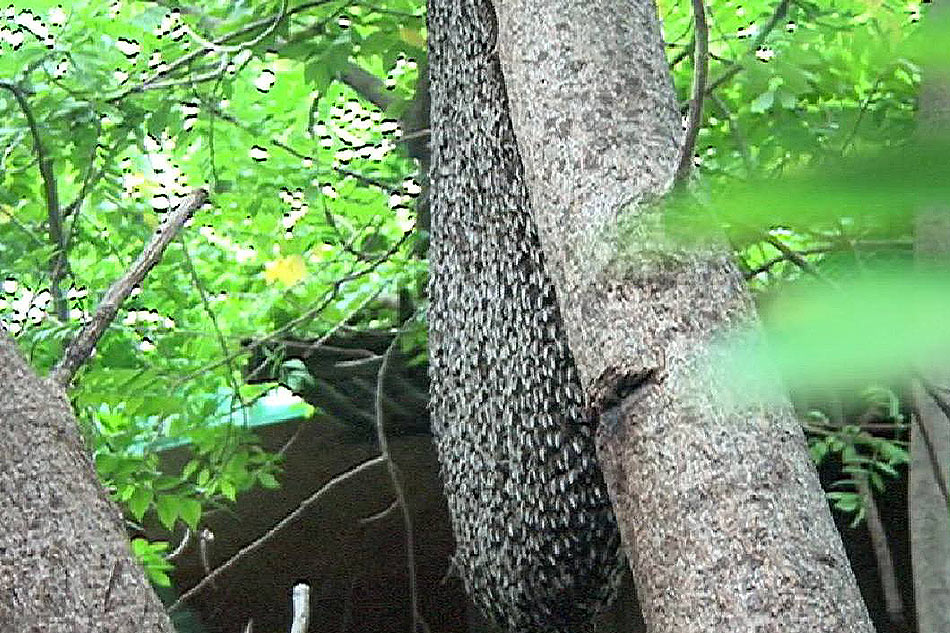Man finds giant 'killer bee' nest outside house | ABS-CBN

Welcome, Kapamilya! We use cookies to improve your browsing experience. Continuing to use this site means you agree to our use of cookies. Tell me more!
Man finds giant 'killer bee' nest outside house
Man finds giant 'killer bee' nest outside house
Carmela Jimenez,
ABS-CBN News
Published Jul 19, 2016 11:55 PM PHT
LA UNION - A man has discovered a huge beehive on a tree outside his house in Barangay 3, San Fernando City in La Union.
LA UNION - A man has discovered a huge beehive on a tree outside his house in Barangay 3, San Fernando City in La Union.
It has been five months since Rommel Llarenas noticed the beehive hanging in a tree he planted. It was not until the bees started coming in his house that he decided to seek the help of the Office of the Provincial Agriculturist.
It has been five months since Rommel Llarenas noticed the beehive hanging in a tree he planted. It was not until the bees started coming in his house that he decided to seek the help of the Office of the Provincial Agriculturist.
"Marami silang nagliliparan diyan. Nangangagat sila, ganun. Naaapakan kasi nila, kinakagat sila. Baka mamaya lilipat sila sa bahay. Killer bees siguro 'yang mga 'yan, matatapang eh. Hindi naman cultured 'yan na bees sabi nung taga-DMMSU (Don Mariano Marcos Marcos State University)," Llarenas said.
"Marami silang nagliliparan diyan. Nangangagat sila, ganun. Naaapakan kasi nila, kinakagat sila. Baka mamaya lilipat sila sa bahay. Killer bees siguro 'yang mga 'yan, matatapang eh. Hindi naman cultured 'yan na bees sabi nung taga-DMMSU (Don Mariano Marcos Marcos State University)," Llarenas said.
From being only a foot long in January, the beehive has grown to four feet.
From being only a foot long in January, the beehive has grown to four feet.
ADVERTISEMENT
Llarenas' son said the bees are attracted to light.
Llarenas' son said the bees are attracted to light.
"Magsisimula po 'yan sa konti. Maglalaro lang po sila diyan. Kailangan as much as possible, walang nakailaw dito," he said.
"Magsisimula po 'yan sa konti. Maglalaro lang po sila diyan. Kailangan as much as possible, walang nakailaw dito," he said.
The Office of the Provincial Agriculturist (OPAG) said the bees are Apis dorsata, or giant honey bees. They are locally known as "uyukan."
The Office of the Provincial Agriculturist (OPAG) said the bees are Apis dorsata, or giant honey bees. They are locally known as "uyukan."
"Tinatawag po siyang killer bees dito sa Pilipininas, and one of the largest bees in the Philippines. Kaya po nilang patayin ang isang kalabaw," said Serene Tuyan, an OPAG staff.
"Tinatawag po siyang killer bees dito sa Pilipininas, and one of the largest bees in the Philippines. Kaya po nilang patayin ang isang kalabaw," said Serene Tuyan, an OPAG staff.
Giant honey bees are seen mostly in the mountains, but their nests are sometimes built on tree limbs, buildings, and on rocks. They are known to be aggressive and their sting can trigger an allergy.
Giant honey bees are seen mostly in the mountains, but their nests are sometimes built on tree limbs, buildings, and on rocks. They are known to be aggressive and their sting can trigger an allergy.
The OPAG started a fire under the beehive to drive the bees away from their nest on Tuesday.
The OPAG started a fire under the beehive to drive the bees away from their nest on Tuesday.
ADVERTISEMENT
ADVERTISEMENT


